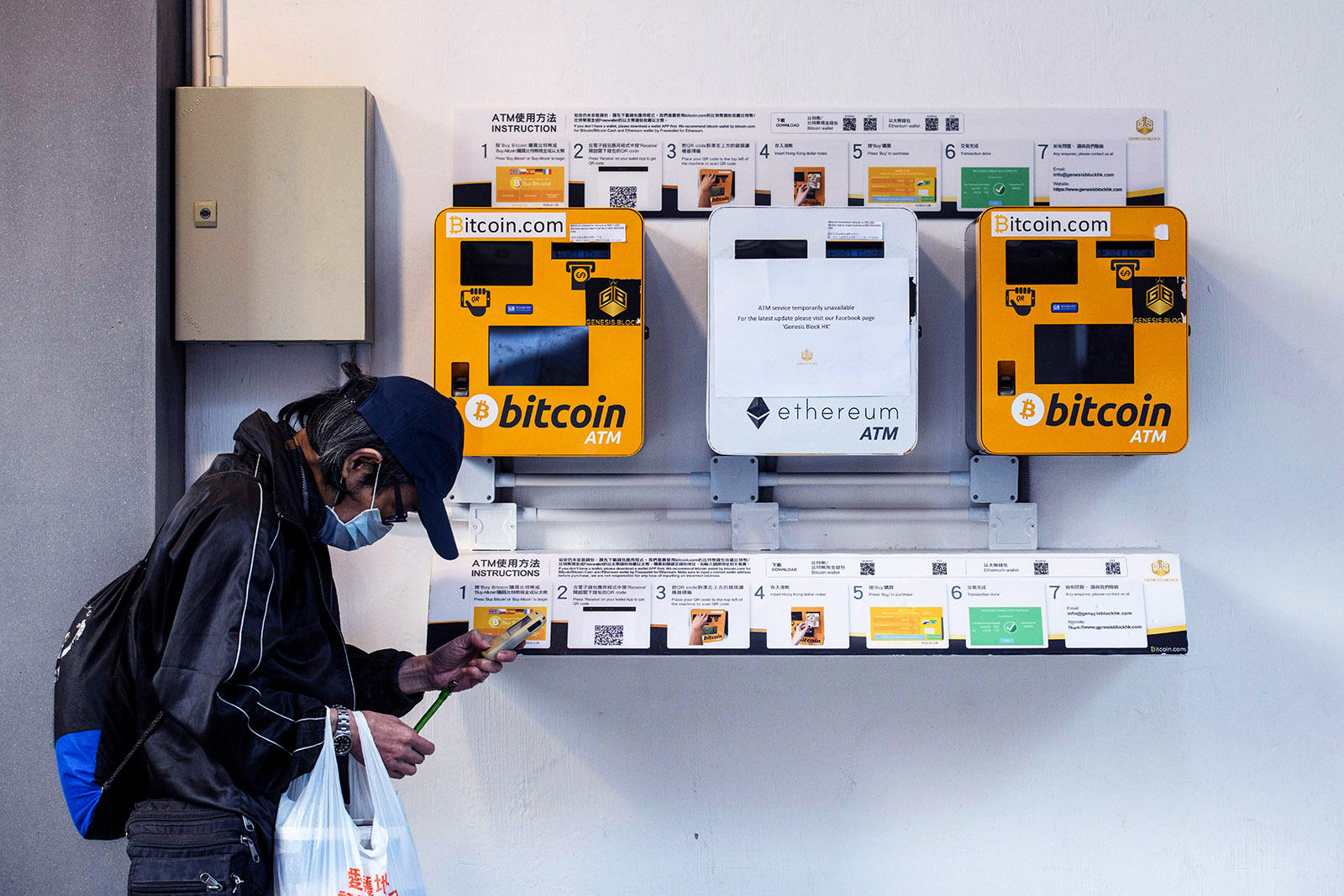Why Central Banks Are Now Taking Digital Currency Seriously

A person uses their phone as they walk past ATM machines for digital currency Bitcoin in Hong Kong. Today there are 150 alternative currencies.
Photo: Anthony Wallace/AFP via Getty Images
The soaring price of Bitcoin has raised the question of whether countries should set up their own digital currencies. A digital currency would be issued by central banks, like banknotes, while cryptocurrencies rely on distributed ledgers like blockchain.
China has already begun piloting a digital yuan currency in several major cities, and the Federal Reserve chairman has said that he will hold a public dialogue about the idea of creating a central bank digital currency. Sergio Focardi is professor of finance at the Pôle Universitaire Léonard de Vinci in Paris.
FOCARDI: At the moment, we have a two-tier banking system in most economies. There are commercial banks and a central bank. Commercial banks have accounts with clients, while central banks only have accounts with commercial banks.
A central bank does a number of supervising activities, but it also creates the base money, formed by bank notes. Bank accounts are debts that each bank has with its clients, payable in banknotes. But nowadays, the amount of money in bank accounts far exceeds any possible amount of bank notes, so the idea that a company might go to a bank and say, “Hey, I want my money back in bank notes,” does not make sense.
Moreover, the public is increasingly moving away from using banknotes. If you travel to countries like Iceland or Norway, the use of bank notes is now really limited, for many different reasons.
Performing the Same Role As Bank Notes
BRINK: So would a central bank’s digital currency perform the same role as a bank note?
FOCARDI: There are currently many projects for central banks digital money. Most major central banks are thinking about issuing some version of digital money. If you look at the E-Krona project of the bank of Sweden, they have a means of payment that has some of the same characteristics of bank notes, except that it’s electronic. So it’s peer to peer, it’s anonymous, but it’s electronic.
At this moment, People’s Bank of China (PBOC) seems to be the first central bank ready to deploy digital money. They have already concluded the test phase and are ready to launch the digital yuan. The digital yuan is not based on blockchain technology. The PBOC is careful not to endorse too strongly any specific technology.
From the user perspective, the digital yuan is like any other electronic wallet. The objective, however, is to replace cash, not bank money, and so commercial banks will play a role in distributing it.
The European Union is still in the research phase. A 2020 report outlines the future plan of the European Union. However, no pilot project has started yet. The first objective is to make the European banking system more modern and more efficient, and technologies are still to be decided.
The creation of digital money is not in itself a major source of risk. The real point is what governments want to do with the money.
Digital Currency Could Be Used for Welfare Payments
The Federal Reserve is discussing plans to issue a digital dollar but no test project has been identified. One element that might distinguish the digital dollar from other central bank digital currency (CBDC) is its use as a welfare tool. With a digital dollar, the FED would be able to make welfare payments, including lump sums paid to citizens.
It is fair to say that there are many projects and many possible solutions. Cryptocurrencies have created central banks’ interest in digital money, but the end result might be completely different from any current cryptocurrency.
BRINK: If this kind of central bank digital currency was introduced, would it cut out the commercial banks?
FOCARDI: That’s a big question mark. The creation of digital money is not in itself a major source of risk. The real point is what governments want to do with the money.
There are radical scenarios where the central bank issues digital currency and has accounts with the public — with you and me. But then, central banks would be in competition with the commercial banks, and central banks are not equipped to deal with millions of clients.
A less radical scenario is where they essentially replace bank notes with digital money, and the commercial banks continue to operate as before. That is where the thinking is today: Most central banks are trying to replace the use of bank notes with a system that is electronic and easier to deal with, still anonymous, but not replacing commercial banks.
Central Banks Are Keeping an Eye on Bitcoin
BRINK: What would a central bank digital currency do to Bitcoin? Do you think that these cryptocurrencies will continue to exist?
FOCARDI: Today there are 150 alternative currencies, but the only one that really keeps ongoing is Bitcoin — the others are marginal. I don’t really believe that governments will just let Bitcoin grow.
No government will want a powerhouse that can control financial transactions without being controlled. I don’t believe that cryptocurrencies will become major actors, at least in the foreseeable future, because it’s against governments’ interest.






